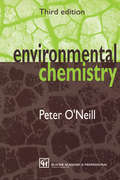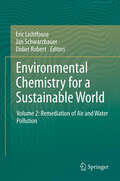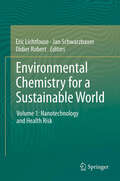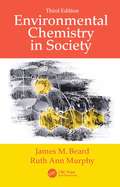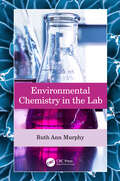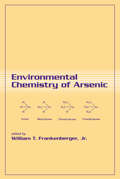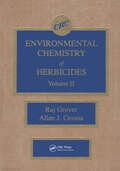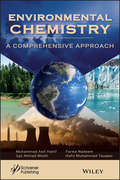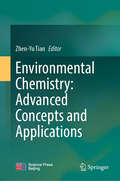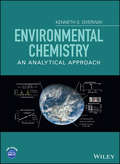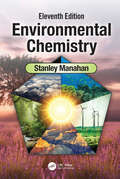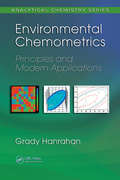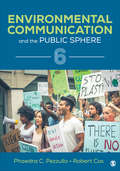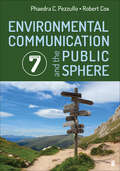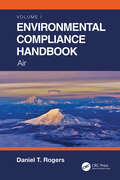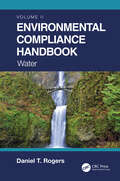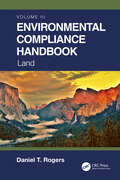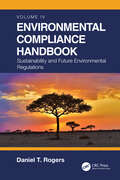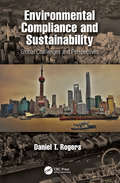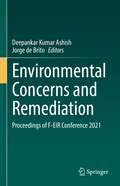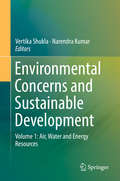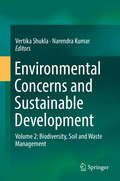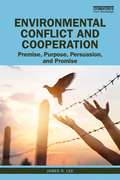- Table View
- List View
Environmental Chemistry (Third Edition)
by Peter O'Neill<p>A complete introduction to environmental chemistry, this book provides insight into the operation of the chemical processes near the Earth's surface. The four-part format groups together related environmental topics and introduces theoretical concepts. Part One brings together many essential basic geological, geochemical, and chemical ideas, and emphasizes the importance of oxygen to the chemistry of reactions near the Earth's surface. <p>Parts Two and Three discuss systems depending on these reaction types, and Part Four examines the effects of human activities on elements that usually cycle naturally in small quantities. Also in this part, the perturbation of natural cycles by agricultural, industrial, and social developments is highlighted in terms of the consequent problems of environmental management.</p>
Environmental Chemistry for a Sustainable World
by Eric Lichtfouse Jan Schwarzbauer Didier RobertEnvironmental chemistry is a fast developing science aimed at deciphering fundamental mechanisms ruling the behaviour of pollutants in ecosystems. Applying this knowledge to current environmental issues leads to the remediation of environmental media, and to new, low energy, low emission, sustainable processes. Nanotechnology applications for alternative energies such as solar power, fuel cells, hydrogen and lithium batteries are reviewed in the first section. Recent investigations on carbon nanotubes, nanocatalysts and cyclodextrins disclose unprecedented techniques to monitor and clean pollutants such as greenhouse gases, heavy metals, pesticides, pathogens occurring in water, air and soil. The second section reviews the risks for human health of critical pollutants such as endocrine disruptors, dioxins and heavy metals contaminating seafood and sediments. An exhaustive review of DDT isomers reveals unexpected mechanisms of DDT transfer to fishes. A chapter on pollutant geochronology using river sedimentary archives provides novel insights on pollution history since the beginning of the anthropocene. This book will be a valuable source of information for engineers and students developing novel applied techniques to monitor and clean pollutants in air, wastewater, soils and sediments.
Environmental Chemistry for a Sustainable World
by Eric Lichtfouse Jan Schwarzbauer Didier RobertEnvironmental chemistry is a fast developing science aimed at deciphering fundamental mechanisms ruling the behaviour of pollutants in ecosystems. Applying this knowledge to current environmental issues leads to the remediation of environmental media, and to new, low energy, low emission, sustainable processes. Nanotechnology applications for alternative energies such as solar power, fuel cells, hydrogen and lithium batteries are reviewed in the first section. Recent investigations on carbon nanotubes, nanocatalysts and cyclodextrins disclose unprecedented techniques to monitor and clean pollutants such as greenhouse gases, heavy metals, pesticides, pathogens occurring in water, air and soil. The second section reviews the risks for human health of critical pollutants such as endocrine disruptors, dioxins and heavy metals contaminating seafood and sediments. An exhaustive review of DDT isomers reveals unexpected mechanisms of DDT transfer to fishes. A chapter on pollutant geochronology using river sedimentary archives provides novel insights on pollution history since the beginning of the anthropocene. This book will be a valuable source of information for engineers and students developing novel applied techniques to monitor and clean pollutants in air, wastewater, soils and sediments.
Environmental Chemistry in Society
by James M. Beard Ruth Ann MurphyThis self-contained text offers all the information necessary for readers to understand the topics surrounding environmental science and the chemistry underlying various issues. It provides a foundation in science, chemistry, and toxicology, including the laws of thermodynamics, chemical bonding, and environmental toxins. This text allows readers to delve into environmental topics, such as energy in society, air quality, global atmospheric concerns, water quality, and solid waste management. The arrangement of the book provides instructors flexibility in how they present the material, with the crucial topics being covered first. This third edition had been updated throughout. Key Features: Extensive revision of the discussion questions at the end of each chapter to require more critical thinking skills. Updates to the environmental data. Includes a glossary of important terms. An excellent, user friendly and thought-provoking presentation which will appeal to students with little or no science background.
Environmental Chemistry in the Lab
by Ruth Ann MurphyEnvironmental Chemistry in the Lab presents a comprehensive approach to modern environmental chemistry laboratory instruction, together with a complete experimental experience. The laboratory experiments have an introduction for the students to read, a pre-lab for them to complete before coming to the lab, a data sheet to complete during the lab, and a post-lab which would give them an opportunity to reinforce their understanding of the experiment completed. Instructor resources include a list of all equipment and supplies needed for 24 students, a lab preparation guide, an answer key to all pre-lab and post-lab questions, sample data for remote learners, and a suggested rubric for grading the labs. Additional features include: • Tested laboratory exercises with instructor resources for environmental science students • Environmental calculations, industrial regulation, and environmental stewardship • Classroom and remote exercises • An excellent, user-friendly, and thought-provoking presentation which will appeal to students with little or no science background • A qualitative approach to the chemistry behind many of our environmental issues today
Environmental Chemistry of Arsenic
by William T. FrankenbergerWith contributions from world-renowned experts in the field, this book explores developments in the transport kinetics, seasonal cycling, accumulation, geochemistry, transformation, and toxicology of arsenic. It details advances in the prevention and control of arsenic and arsenic compounds in the air, soil, and water and offers analytical methods for the detection and study of arsenic in the environment and human body. Providing bioremediation techniques for effective treatment of contaminated water supplies, the book discusses factors that influence the removal of arsenic from water as well as diurnal and seasonal variations in the arsenic concentration of surface water supplies.
Environmental Chemistry of Herbicides
by Raj Grover Allan CessnaThis publication is rare among those texts on pesticides in that it covers herbicides exclusively. It presents, in one source, information that is typically scattered. This important publication enables the reader to recommend herbicide use more reliably and efficiently. It also highlights environmental issues relevant to herbicide use in agriculture. The book outlines potential areas of further research. This title is of particular value to weed scientists, environmental chemists and engineers, soil scientists, and those responsible for recommending and/or regulating use of herbicides in agriculture.Focuses On: Increasing efficiency of herbicides in agriculture Decreasing environmental contamination with herbicides Dissipation and transformations in water and sediment Nature, transport, and fate of airborne residues Absorption and transport in plants Transformations in biosphere Bioaccumulation and food chain accumulation Photochemical transformations Bound residues Predictability and environmental chemistry
Environmental Chemistry: A Comprehensive Approach
by Muhammad A. Hanif Farwa Nadeem Ijaz Ahmad Bhatti Hafiz Muhammad TauqeerThis book is a very comprehensive project designed to provide complete information about environmental chemistry, including air, water, soil and all life forms on earth. The complete chemical composition and all the essential components of the atmosphere, hydrosphere, geosphere, lithosphere and biosphere are discussed in detail. Numerous forms of pollutants and their toxic effects along with sustainable solutions are provided. Not just covering the basics of environmental chemistry, the authors discuss many specific areas and issues, and they provide practical solutions. The problems of non-renewable energy processes and the merits of renewable energy processes along with future fuels are discussed in detail, making this volume a comprehensive collaboration of many other relevant fields which tries to fill the knowledge gap of all previously available books on the market. It also thoroughly covers all environment-related issues, internationally recognized standard values, and the socioeconomic impacts on society for the short and long term. A valuable reference for engineers, scientists, chemists, and students, this volume is applicable to many different fields, across many different industries, at all levels. It is a must-have for any library.
Environmental Chemistry: Advanced Concepts and Applications
by Zhen-Yu TianThis book is a comprehensive guide that explores the intricate relationship between chemistry and the environment. The book offers a systematic study of various aspects, including basic chemical concepts, atmospheric chemistry, phase interactions, water pollution and treatment, the atmosphere and its chemistry, particles in the atmosphere, photochemical smog, the geosphere, geochemistry, and soil chemistry. It offers a blend of theoretical explanations, practical examples, detailed illustrations, and tables to facilitate a deeper understanding of the subject matters. The book’s uniqueness is its ability to simplify complex scientific concepts and present them in an accessible and engaging manner. It employs a didactic approach, making learning a proactive and enjoyable process. Readers appreciate the in-depth exploration of topics such as the law of conservation of matter, the role of the atmosphere in safeguarding life on Earth, the formation of photochemical smog, the evolution of the geosphere, and the role of soil colloids in soil chemistry. It emphasizes the importance of understanding these concepts to address environmental challenges effectively. The key benefit for readers is gaining a comprehensive understanding of environmental chemistry, its concepts, and its real-world applications. This book serves as an essential resource for those aiming to gain in-depth understanding of the subject and its significance in preserving our planet. This makes it particularly appealing to students, researchers, and professionals interested in environmental sciences.
Environmental Chemistry: An Analytical Approach
by Kenneth S. OverwayCovers the essentials of environmental chemistry and focuses on measurements that can be made in a typical undergraduate laboratory Provides a review of general chemistry nestled in the story of the Big Bang and the formation of the Earth Includes a primer on measurement statistics and quantitative methods to equip students to make measurements in lab Encapsulates environmental chemistry in three chapters on the atmosphere, lithosphere and hydrosphere Describes many instruments and methods used to make common environmental measurements
Environmental Chemistry: Eleventh Edition
by Stanley E ManahanWith clear explanations, real-world examples and updated ancillary material, the 11th edition of Environmental Chemistry emphasizes the concepts essential to the practice of environmental science, technology and chemistry. The format and organization popular in preceding editions is used, including an approach based upon the five environmental spheres and the relationship of environmental chemistry to the key concepts of sustainability, industrial ecology and green chemistry. The new edition provides a comprehensive view of key environmental issues, and significantly looks at diseases and pandemics as an environmental problem influenced by other environmental concerns like climate change. Features: The most trusted and best-selling text for environmental chemistry has been fully updated and expanded once again The author has preserved the basic format with appropriate updates including a comprehensive overview of key environmental issues and concerns New to this important text is material on the threat of pathogens and disease, deadly past pandemics that killed millions, recently emerged diseases and the prospects for more environment threats related to disease This outstanding legacy appeals to a wide audience and can also be an ideal interdisciplinary book for graduate students with degrees in a variety of disciplines other than chemistry New! Long-awaited companion website featuring additional ancillary material
Environmental Chemometrics: Principles and Modern Applications
by Grady HanrahanMultivariate, heterogeneous data has been traditionally analyzed using the "one at a time" variable approach, often missing the main objective of discovering the relationships among multiple variables and samples. Enter chemometrics, with its powerful tools for design, analysis, and data interpretation of complex environmental systems. Delineating
Environmental Communication and the Public Sphere
by Robert Cox Phaedra C. PezzulloThe best-selling Environmental Communication and the Public Sphere provides a comprehensive introduction to the growing field of environmental communication. This groundbreaking book focuses on the role that human communication plays in influencing the ways we perceive the environment. Authors Phaedra C. Pezzullo and Robert Cox examine how we define what constitutes an environmental problem and how we decide what actions to take concerning the natural world. The Sixth Edition explores recent events and research, including fast fashion, global youth climate strikes, biodiversity loss, disability rights advocacy, single-use plastic ban controversies, and the COVID-19 pandemic.
Environmental Communication and the Public Sphere
by Robert Cox Phaedra C. PezzulloThe best-selling Environmental Communication and the Public Sphere provides a comprehensive introduction to the growing field of environmental communication. This groundbreaking book focuses on the role that human communication plays in influencing the ways we perceive the environment. Authors Phaedra C. Pezzullo and Robert Cox examine how we define what constitutes an environmental problem and how we decide what actions to take concerning the natural world. The Sixth Edition explores recent events and research, including fast fashion, global youth climate strikes, biodiversity loss, disability rights advocacy, single-use plastic ban controversies, and the COVID-19 pandemic.
Environmental Communication and the Public Sphere
by Robert Cox Phaedra C. PezzulloThe Seventh Edition of the award-winning Environmental Communication and the Public Sphere is the best-selling comprehensive introduction in the field of environmental communication. This groundbreaking book focuses on the role that human communication plays in influencing the ways we perceive, transform, and attempt to heal relations with everything we consider to be "the environment" - from microscopic chemicals in cosmetics to the climate we breathe. Authors Phaedra C. Pezzullo and Robert Cox examine how we define what constitutes an environmental problem and how we decide what actions to take concerning the natural world. The updated and revised Seventh Edition explores recent events and research that have emerged since the last edition, including: the latest on the impact of artificial intelligence (AI) on journalism, climate commitments of Big Tech, global climate justice course cases, mutual aid networking, ultra-processed food policy, anti-plastics advocacy, expanding legal rights of nonhuman animals, and more.
Environmental Communication and the Public Sphere
by Robert Cox Phaedra C. PezzulloThe Seventh Edition of the award-winning Environmental Communication and the Public Sphere is the best-selling comprehensive introduction in the field of environmental communication. This groundbreaking book focuses on the role that human communication plays in influencing the ways we perceive, transform, and attempt to heal relations with everything we consider to be "the environment" - from microscopic chemicals in cosmetics to the climate we breathe. Authors Phaedra C. Pezzullo and Robert Cox examine how we define what constitutes an environmental problem and how we decide what actions to take concerning the natural world. The updated and revised Seventh Edition explores recent events and research that have emerged since the last edition, including: the latest on the impact of artificial intelligence (AI) on journalism, climate commitments of Big Tech, global climate justice course cases, mutual aid networking, ultra-processed food policy, anti-plastics advocacy, expanding legal rights of nonhuman animals, and more.
Environmental Compliance Handbook, Volume 1: Air
by Daniel T. RogersEnvironmental laws and regulations are extremely complex and difficult to understand. In order to comply with them, they need to be explained in layperson’s terms. This handbook identifies many changes in regulations and recommends ways to apply and implement them. Containing the latest environmental information, this volume addresses environmental compliance with air and provides a historical perspective to help follow the logical growth and increased complexity of air regulations through time. Structured as a “step-by-step how-to” book, readers will find real-life examples for the most important aspects of language, permit terms, demonstrating compliance, and organization for air projects. Features: Identifies all air pollution control regulations and the requirements of any air pollution control permits available up to date. Answers in depth all practical questions that arise when working on compliance projects in a “how to” method. Addresses a wider spectrum of issues that go beyond chemical-based contamination and environmental regulations and examines the impacts of climate change Includes many real-life examples from industry and institutions that comply with air quality regulations and air pollution control permits It is global in coverage and very useful to companies that have expanded operations outside their country of origin.
Environmental Compliance Handbook, Volume 2: Water
by Daniel T. RogersEnvironmental laws and regulations are extremely complex and difficult to understand. In order to comply with them, they need to be explained in layperson’s terms. This handbook identifies many changes in regulations and recommends ways to apply and implement them. Containing the latest environmental information, this volume addresses environmental compliance with water and provides a historical perspective to help follow the logical growth and increased complexity of water regulations through time. Structured as a “step-by-step how-to” book, readers will find real-life examples for the most important aspects of language, permit terms, demonstrating compliance, and organization for water projects. Features: Identifies all water pollution control regulations and the requirements of any water pollution control permits available up to date Answers in depth all practical questions that arise when working on compliance projects in a "how-to" method Addresses a wider spectrum of issues that go beyond chemical-based contamination and environmental regulations and examines the impacts of climate change Includes many real-life examples and case studies from industry and institutions that comply with water quality regulations It is global in coverage and very useful to companies that have expanded operations outside their country of origin
Environmental Compliance Handbook, Volume 3: Land
by Daniel T. RogersEnvironmental laws and regulations are extremely complex and difficult to understand. In order to comply with them, they need to be explained in layperson’s terms. The handbook identifies many changes in regulations and recommends ways to apply and implement them. Containing the latest environmental information, this third volume addresses environmental compliance with land and provides a historical perspective to help follow the logical growth and increased complexity of land regulations through time. Structured as a “step-by-step how-to” book, readers will find real-life examples for the most important aspects of language, permit terms, demonstrating compliance, and organization for land projects. Features: Introduces all land pollution control regulations and the requirements of any land pollution control permits available up to date Answers in depth all practical questions that arise when working on compliance projects in a "how-to" method Addresses a wider spectrum of issues that go beyond chemical-based contamination and environmental regulations and examines the impacts of climate change Includes many real-life examples and case studies from industry and institutions that comply with land use regulations It is global in coverage and very useful to companies that have expanded operations outside their country of origin
Environmental Compliance Handbook, Volume 4: Sustainability and Future Environmental Regulations
by Daniel T. RogersEnvironmental laws and regulations are extremely complex and difficult to understand. In order to comply with them, they need to be explained in layperson’s terms. This handbook identifies many changes in regulations and recommends ways to apply and implement them. Containing the latest environmental information, this volume goes beyond environmental regulations in two fundamental aspects: sustainability and preparation for future requirements before mandates are enacted. Structured as a “step-by-step how-to” book, readers will find real-life examples for the most important aspects of evaluating sustainability initiatives and preparing for new and revised environmental regulations. Features: Explores all sustainability related concepts and regulations and the requirement of any control permits available up to date. Answers in depth all practical questions that arise when working on compliance projects for future requirements. Addresses a wider spectrum of sustainability issues that go beyond chemical-based contamination and environmental regulations and examines the impacts of climate change. Includes many real-life examples and case studies from industry and institutions that comply with sustainability regulations. It is global in coverage and very useful to companies that plan to expand operations outside their country and are interested in future regulations.
Environmental Compliance and Sustainability: Global Challenges and Perspectives
by Daniel T. RogersThis book provides a critical understanding of the challenges that exist in protecting the local and global environment through compliance efforts using existing environmental regulations. The best compliance measures with the most useful regulations from over 50 countries are surveyed and are combined with science-based quantitative analysis of geology, hydrogeology, and the chemistry of contaminants from anthropogenic sources. The results are presented as a model that establishes a means by which protection of the environment can be greatly improved. This is accomplished through a deeper understanding of our natural world and how anthropogenic activities and their management affect our planet. Features The first book that examines the successes of environmental regulation worldwide and highlights the areas that need improvement Presents a tested and verified scientific model for enhanced environmental protection with scalability from local parcels to global levels Describes and integrates the importance of understanding the geologic and hydrogeologic environment of urban and developed areas Explains the importance of understanding the different types of pollution and their behavior in the environment Identifies the need for consistency in banning chemicals that are harmful in not just one country but throughout the world
Environmental Concerns and Remediation: Proceedings of F-EIR Conference 2021
by Jorge De Brito Deepankar Kumar AshishThis book presents the conference proceedings of the F-EIR Conference 2021, Environment Concerns and its Remediation held in Chandigarh, India, October 18–22, 2021. The purpose of the conference and the volume is to present new ideas across a range of disciplines in environmental science, with a focus on theoretical and practical approaches to clean production aimed at preventing the production of waste, while increasing efficiencies in the uses of energy, water, and renewable resources. With contributions from leading experts equipped with state-of-the-art information and technology, the book covers topics of sustainability and resilience, chemical and environmental engineering, materials science, biotechnology, health-related microorganisms, and green technologies. The book will be of interest to scientists, engineering professionals, architects, environmental scientists, academicians, economists, and students engaged in these disciplines.
Environmental Concerns and Sustainable Development: Volume 1: Air, Water and Energy Resources
by Narendra Kumar Vertika ShuklaThe prevailing global environmental crisis is primarily because of non-standardized parameters for environmental regulation. Unplanned expansion of economic activities, consideration for environmental conservation and several associated problems are emerging due to degradation in quality of ambient environment such as clean air, safe drinking water and quality of food, particularly in developing nations. Due to poor/casual execution of EIA protocol, newly developing countries are preferred destination for establishing pollution emitting industries, which results in degradation and depletion of natural resources. Lack of environmental policy intervention is another major attraction for establishing such industries in these nations. In order to ensure sustainable development, the highest priority issues include the monitoring and eradication of environmental problems which arise due to economic development. Initiation of any form of economic development primarily results in loss of forests and thus biodiversity, followed by deterioration in quality of air and contamination of natural resources. The worst impact of non-standardized economic development is the contamination of air, water and soil. Sustainable development ensures responsible interface with the environment to minimize the depletion or degradation of natural resources and ensure long term environmental quality. It involves integrated approaches in understanding the importance of environmental management systems and policy inventions leading to improved environmental performance. The present book is proposed to address the environmental concerns associated with economic development and approaches involved to attain sustainable economic development, which include monitoring of the quality of air, deforestation, quality of water resources, soil erosion and degradation of the natural environment.
Environmental Concerns and Sustainable Development: Volume 2: Biodiversity, Soil and Waste Management
by Narendra Kumar Vertika ShuklaThe current global environmental crisis is primarily the result of non-standardized parameters for environmental regulation, and is impacting e.g. clean air, safe drinking water and the quality of food, particularly in developing nations. Due to their poor/lax execution of EIA protocols, newly developing countries are preferred destinations for establishing pollution-emitting industries, which results in the degradation and depletion of their natural resources. Lack of environmental policy intervention is another major incentive to base “dirty” industries in these nations. In order to ensure sustainable development, the highest-priority issues include the monitoring and eradication of environmental problems stemming from economic development; virtually every form of economic development primarily results in the loss of forests and thus biodiversity, followed by declining air quality and the contamination of natural resources. Sustainable development ensures responsible interactions with the environment, so as to minimize the depletion or degradation of natural resources and preserve environmental quality. It involves integrated approaches to understanding the importance of environmental management systems and policy measures that lead to improved environmental performance. This book addresses the environmental concerns associated with economic development, and with approaches to attaining sustainable economic development, which include monitoring the quality of water resources, soil erosion and degradation of the natural environment.
Environmental Conflict and Cooperation: Premise, Purpose, Persuasion, and Promise
by James R. LeeEnvironmental Conflict and Cooperation explores the evolution of environmental conflict as a field of research and the study of cooperation as an alternative to war. Over four key parts, James R. Lee navigates the contours of this growing field and paints a vivid framework for better understanding issues around environmental conflict and security: • The premise of the field and its historic manifestations • The definition and purpose of research • The persuasions or types of environmental conflict and cooperation • The promise of research in leading to better decision-making and to broaching new challenges. Over the course of these parts, the author outlines the deep historic record of this discipline, arguing that it will play a key role in understanding important future trends. Utilizing a wide variety of case studies that range from ancient examples, including conflict over the Cedars of Lebanon and the role of tin in the Peloponnesian Wars, to future-oriented scenarios, including expanded island-building in the South China Sea and the global politics of geo-engineering, Lee highlights key concepts, metrics, and policy contexts that will test current understandings. He also examines a variety of research methods and provides examples of the ways in which such research can be used to inform policy improvements. This book will draw specific interest from students and scholars of environmental conflict and cooperation, as well as researchers of environmental politics and security studies.
